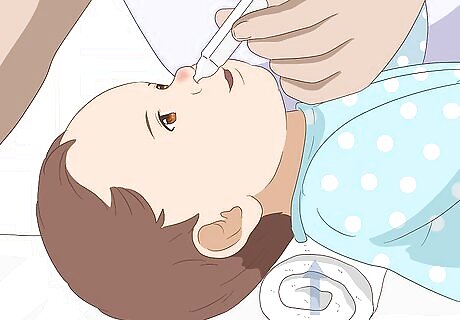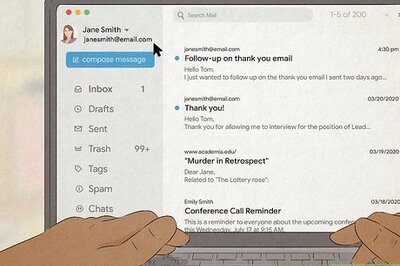
views
Getting Immediate Relief
Take a hot shower to quickly thin out mucus. Steam helps to thin nasal secretions, which can make breathing easier. For a quick solution, close the bathroom door, jump in a hot shower, and let the steam work its magic. Hopefully, you’ll be feeling better in no time. As an alternative, let a hot shower run while you simply sit in the bathroom with the door closed. A cool-mist humidifier can also help clear up a stuffy nose, so run one in your bedroom at night if you can. Make sure to clean it weekly. If you don't own a cool-mist humidifier, you can explore several options for purchase here.
Use a saline spray or neti pot for a natural solution. Saline nasal sprays are simply salt water in a convenient applicator, so they’re safe for everyone, even pregnant women, to use. The water will flush out the mucus and soothe the inflammation in your nose. Follow the instructions on the packaging. Typically, you’ll administer 1-2 sprays or drops every 2 to 3 hours. Alternatively, use a neti pot to flush out your sinuses. However, make sure you never fill a neti pot or create a saline solution with tap water as it may contain bacteria or amoebas that can cause life-threatening illness. Also, keep your neti pot very clean by washing it after each use. You can find saline spray options for purchase here and neti pot options here.
Use nasal adhesive strips to open up your nostrils at night. These thin white strips go over the bridge of your nose and are meant to manually widen your nostrils just enough to help you breathe easier. Pick up a pack and apply one to see if it helps you sleep better by reducing your congestion. These are often marketed as anti-snoring strips–you can find options available for purchase here.
Put a warm compress over your nose or forehead to reduce sinus pressure. Heat may help to reduce pressure by opening up your sinuses. Wet a washcloth with water that's as hot as you can stand, lie down, and lay the cloth over the bridge of your nose so that it covers your sinuses but leaves the path to your nostrils clear. Alternatively, place the cloth over your forehead. Rewet the washcloth when it starts to feel uncomfortably cold. It might take a few rounds of reheating the washcloth for you to feel any benefit, so be patient. Try using a compress while you do something relaxing, like listening to music or watching TV.
Take an OTC decongestant or antihistamine if recommended by your doctor. Depending on the cause of the stuffiness, you might be able to find some relief with an over-the-counter (OTC) medication. If your child between the age of 4 to 12 is sick, choose a decongestant or antihistamine formulated especially for children. Be sure to speak to your doctor before taking medication of any kind and ask what they recommend for your specific symptoms. If you have a cold, a decongestant can ease the swelling and inflammation in your nasal passages, leading to easier breathing. You can take this medication orally, as a pill or liquid, or use a decongestant nasal spray. Be aware that decongestant nasal sprays are only recommended for 3 consecutive days of use due to the risk of rebound congestion, while oral decongestants can be taken for up to 5 to 7 days. You can find decongestant options online for purchase here. If you're suffering from allergies, such as hay fever, get an antihistamine, such as Claritin, Zyrtec, or Allegra, or the generic equivalent of one of these medications. An antihistamine will both relieve congestion and take care of other symptoms, like sneezing. Be aware that some antihistamines can make you feel tired. Look for non-drowsy options to take during the day and wait to drive or use heavy machinery until you see how the antihistamine affects you. Flonase and Nasacort sprays, which contain corticosteroids, may also be helpful if your nose is congested due to allergies. Corticosteroids help reduce inflammation.
Modifying Your Routine

Blow your nose gently. If your nose is stuffed up but not dripping, or mucus isn't coming out easily when you blow your nose, don't force it. Your impulse may be to blow your nose until you expel some mucus, but it's best if you leave the tissues alone. Only blow your nose when it is running. Note: Blowing hard repeatedly will make the delicate membranes inside your nostrils get more inflamed, and can quickly lead to increased stuffiness. It seems counter-intuitive at first, but you really will feel better if you use tissues less often.
Hydrate yourself to thin out the mucus. Drinking lots of fluids when you’re sick can help clear up a stuffy nose. Stick with plain water, herbal tea, or broth and keep a water bottle or mug on hand at all times to encourage hydration. Comfortably hot beverages are especially helpful for thinning out mucus. Avoid sugary beverages like juice and soda since they don't contain any helpful nutrients or electrolytes your body needs. Sugar may also prevent your immune system from functioning properly. Stay away from caffeine, such as in coffee, as it can be dehydrating.
Prop up your head when you’re resting. Lying flat on your back can cause mucus to build up while you rest or sleep. Elevate your head with a few pillows or snooze in a recliner when you have a stuffy nose. If you typically sleep on your stomach or side, try sleeping on your back and elevating your head while you're sick.
Stay away from irritants. Irritants like cigarette smoke can make a stuffy nose worse. Avoid smoking or being around others who smoke when you’re congested. If your stuffy nose is due to allergies, do your best to avoid common allergens, like dust and pet dander. If you need help to quit smoking, speak to your doctor or contact the Quitline at 1-800-QUIT-NOW.
Treating Babies and Toddlers

Use saline drops to loosen the mucus. Place the infant on a flat surface and position a rolled towel beneath their shoulders to tip their head back. Place a few drops of saline solution in each nostril. Saline solution breaks up the mucus so it can be removed, allowing your little one to breathe more easily. To make your own saline solution, mix 1/4 teaspoon (1.42 grams) of non-iodized salt with ⁄2 cup (120 mL) of filtered or distilled lukewarm water. If you only have tap water on hand, boil it and allow it cool before using to make a saline solution. Otherwise, you could introduce bacteria or amoebas into your child’s sinus cavity, which, while rare, can be life-threatening.
Drain the mucus to make it easier for your child to breathe. If your child is old enough to blow their nose, have them do so gently. If you have an infant, use a bulb syringe to remove excess mucus from each nostril. First, squeeze out the air in the bulb, then carefully insert the tip into one of the baby’s nostrils. Release the bulb to suck up the mucus, then remove it from the nostril and squeeze out the mucus onto a tissue. Repeat on the other side. Alternative, roll a tissue into a small cone and swab it around the nostrils. Do not insert cotton swabs into an infant's nose.
Put a cool-mist humidifier in your baby’s room. A cool-mist humidifier can soften mucus and ease your child’s breathing. Set up the humidifier in their bedroom and run it throughout the night. If possible, fill the humidifier with filtered water. Be sure to clean it weekly to keep germs from spreading. Warning: Avoid using warm-mist humidifiers, as these are actually more likely to breed bacteria and distribute germs throughout your home. However, if you don’t have a humidifier, you can run a hot shower and sit with your baby in the bathroom (not the shower itself) so the steam loosens up the mucus. This is especially helpful if your child has a croupy cough.
Elevate your baby’s head while they’re sleeping. Roll up a towel and place it under your child’s crib mattress. Rest their head on the elevated portion of the mattress to allow mucus to drain away rather than clog up their nostrils as they sleep. Never elevate your child’s head using a pillow as this can increase the risk of Sudden Infant Death Syndrome (SIDS).
Do not give your child cold medicine. Over-the-counter cold medicine is not suitable for children under 4 years of age. In fact, decongestants have even been linked to irregular heartbeats as well as irritability. Try to keep your child comfortable as best you can, and call their pediatrician if you have any concerns.
When to Seek Medical Treatment
Get immediate care for sinus pain coupled with yellow or green discharge. Yellow or green discharge often means you have an infection, though this isn’t always the case. However, your doctor needs to rule out an infection or prescribe the right type of treatment. Keep in mind that you can develop a bacterial infection due to sinus drainage, so what started out as a stuffy nose due to allergies or a cold can turn into a bacterial infection. If this happens, your doctor can prescribe a round of antibiotics that will have you feeling better much quicker than going without treatment. Rarely, you may experience blood-tinged or red discharge. If this happens, see your doctor immediately.
Visit your doctor if your congestion continues longer than 10 days. A stuffy nose should go away within a week, so you may have an infection if yours lasts longer than 10 days. Your doctor can rule out other possible causes, such as the flu, and prescribe treatment if you need it. Here are some other symptoms you may be experiencing if you have an infection: Fever over 101.3 °F (38.5 °C) Sore throat Runny or stuffy nose Congestion Headaches Body aches Fatigue
Call your doctor for advice if your baby is under 3 months old. It’s common for babies to get stuffy noses often, as their immune system is just starting to develop. However, a stuffy nose due to a cold or allergies can quickly become serious for a young infant. Fortunately, your doctor can advise you on how to provide the best care for your baby to help their recovery. Your doctor may advise you to continue caring for your baby at home. If your baby has a fever above 100.4 °F (38.0 °C), ask your doctor for a same-day appointment or take your baby to an urgent care center. A fever indicates that they may have an infection, so it’s best to make sure your baby doesn’t need extra treatment.


















Comments
0 comment